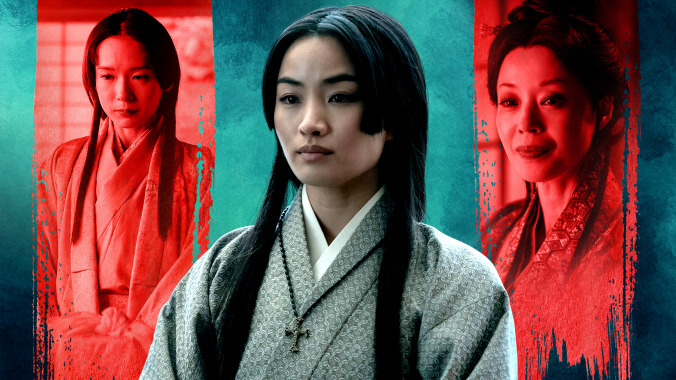Women are stealing the show in Shōgun
In the epic story of Lord Toranaga and John Blackthorne, female characters have become the series' backbone
TV Features Shōgun
FX’s Shōgun—easily already one of 2024's best TV shows—brings James Clavell’s novel to life in a way the 1980 limited series did not. It compellingly unspools the tale of Lord Yoshii Toranaga’s (Hiroyuki Sanada) ascension in 1600s Japan and is rife with battle sequences, beheadings, bombings, and verbal combat about religion and love (sometimes over sake!). As action-packed as it is, Shōgun is equally emotionally thrilling thanks largely to how it distinctly brings multiple female protagonists into the forefront unlike its predecessor (or even the novel).
Like the source material, the series relies on the unexpected kinship between the two male leads: a fierce, wise Toranaga and the sort-of-dorky John Blackthorne (Cosmo Jarvis), a marooned English sailor initially taken as a prisoner. Blackthorne earns his place in the inner circle bit by bit. He’s used as a ploy before proving useful to Toranaga, who’s fighting a plethora of enemies to survive and thrive. The link between them is, of course, the interpreter Toda Mariko (Anna Sawai). Thankfully, she’s not a mere device to forward the pair’s agendas or used solely as Blackthorne’s eyes into a culture and landscape that’s new to him. Instead, Mariko blooms into Shōgun’s beating heart with a poignant storyline—and she’s not the only one.
The writing team, including creators Rachel Kondo and Justin Marks, beautifully spotlight Mariko’s journey along with characters like Usami Fuji (Moeka Hoshi), Gin (Yuko Miyamoto), Lady Ochiba (Fumi Nikaido), and Kiku (Yuka Kouri). Their stories are interwoven into the show to make Shōgun feel more beguiling and authentic—and not just a testosterone-heavy spectacle with sword-fighting and wartime madness. The drama constantly finds ways to depict its women as vulnerable yet badasses pushing for power and freedom in their ways and despite the times they’re living in.
In an earlier interview with The A.V. Club, Sawai said one reason she was drawn to Shōgun was to bring more “depth and reality” into how Japanese women are usually portrayed onscreen. She didn’t want to be limited to the archetype of being sexy or submissive. The series successfully rises above these one-note tropes to give Mariko, Lady Ochiba, Fuji, and the others well-developed arcs. After being taught to shrink and adapt their whole lives, Shōgun’s women are vying for agency, no matter what it takes. Watching them sharply navigate the politics and bloodshed has become the show’s most interesting aspect.
Mariko is imperative as the show progresses, with Sawai’s layered performance adding to it. She displays loss, regret, misery, and occasional joy bubbling underneath Mariko’s stoic, dutiful face. Thankfully, Shōgun purposefully fleshes out her internal world, struggles, desires, and backstory. Torn between her loyalty to Toranaga, her obligation to her not-actually-dead husband Buntaro (Shinnosuke Abe), and growing feelings for Blackthorne, she morphs into the most intriguing figure on our screens: a secret rule-breaker, a skilled fighter, and someone with an astute understanding of how to operate in a patriarchal world.
But Mariko’s tenacity also factors into her interactions with the other women, especially Fuji, whom she helps along the way. Their interactions with Blackthorne since episode four are some of the show’s tensest, most unpredictable, yet oddly enjoyable scenes. Once again, it’s because Shōgun deftly maneuvers Fuji’s arc. She’s not in the background of Blackthorne’s story as his grief-stricken consort, or tagging along with Mariko for the sake of representation.
We haven’t forgotten Lady Ochiba, Toranaga’s truest foe, who makes a grander entrance halfway through the series. She plots his downfall behind the scenes, convinced Toranaga is responsible for her husband’s death. Nothing motivates more than revenge, beckoning a hopefully meatier storyline for Lady Ochiba in the second half of the show as she partners with another of his rivals, Ishido (Takehiro Hira). The women of Shōgun initially come across as isolated widows, mothers grieving their babies, or being in a disastrous marriage. They can be summed up in a word: helpless. No wonder it’s enthralling to witness these clichés peeled back week after week.
Look at Gin of the Ajiro “teahouse,” a brothel business owner who uses her traits to advance her livelihood. Inspired by courtesans from Japan’s Sengoku period, she’s considered elegant and beautiful. But as with Fuji or Kiku—the latter works for Gin—she doesn’t succumb to a flimsy narrative. Both Gin and Kiku’s careers are the result of them being cunning and observant, and as future Shōgun episodes will reveal, they add to the show’s solid emotional core. In fact, Shōgun’s women aren’t just great additions to a compelling story. They’re now the anchors that ground a brilliant television drama.